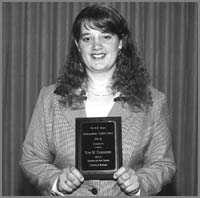 Kim Hemmesch can spot a weed in a cornfield from a car zipping by at 60 mph.
Kim Hemmesch can spot a weed in a cornfield from a car zipping by at 60 mph.After all, she learned about weeds in college and as the new acting University of Minnesota Extension Educator for Blue Earth County, Hemmesch is also brushing up on her knowledge of central Minnesotaís crops, soils and insects.
Hemmesch, 24, began her year on the job on July 1. She will serve in the position while Kent Thiesse is on leave. Thiesse is on a special assignment with the extension service as a liaison between the service and the Association of Minnesota Counties.
Getting acquainted with the crop production in the county and the people involved is Hemmeschís first goal. She wants to get out into the fields and work with farmers.
ďThatís the best way to learn, hands-on, because every situation is different,Ē she said.
She will serve as the crop systemís specialist for the south central cluster. Hemmeschís responsibilities include the Minnesota River Educational Initiative, agricultural drainage programs, the annual cash rental survey and special workshops.
Hemmesch will draw on her own farming background for her new job. A native of Paynesville, she grew up on a dairy farm. She still heads back home (Math and Karen Hemmesch) on weekends to help milk cows, cut alfalfa, bale the hay and other farm work.
ďItís good to be home working,Ē she said, noting that the pressure to get the hay baled up before it rains is exciting, in a different way than her weekday job.
She spent the first two of her college years studying at the University of Minnesota-Morris and then transferred to the St. Paul campus for her bachelorís degree in animal and plant systems. Her studies had a primary emphasis on crops and soils and integrated pest manage-ment.
After completing her bachelorís degree, Hemmesch went to Washington State University with intentions of continuing with graduate studies. She served as a research assistant for a weed scientist at the university. She also worked on weed research projects during her years at the U of M.
Hemmesch sees a key part of her job in getting information about the changes in agriculture out to farmers.
ďSometimes things get lost,Ē she said. ďthatís my job to bring the information locally.Ē
With a farm background, Hemmesch knows each producer has a unique farming operation, with specific challenges. Helping with those problems and situations need to be tailored to that farm, she added.
ďThereís never one answer, you are looking at complex situations for each farmer,Ē she said.
The number of women who are involved in agriculture encourages Hemmesch. ďThere are women in ag at all levels, thatís exciting,Ē she added.
The changes in production agriculture mean changes for farmers. ďYou donít have one so-called Ďfarmer,í now,Ē she said.
Hemmesch wants farmers to know that educating the nonfarm population is more important than ever. In college, she was involved in Minnesotaís Ag in the Classroom project.
ďWe have reached a point that the kids donít know where bread comes from,Ē she said. ďThey say Ďfrom the grocery store.íĒ
That answer frightens Hemmesch, she said.†Only two percent of the stateís population farms to produce food for the other 98 percent. That larger portion makes the decisions for the smaller demographic, so educating people about farming is critical.
(The article is reprinted with permission from the July 30 issue of the Agri News.)